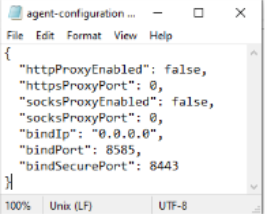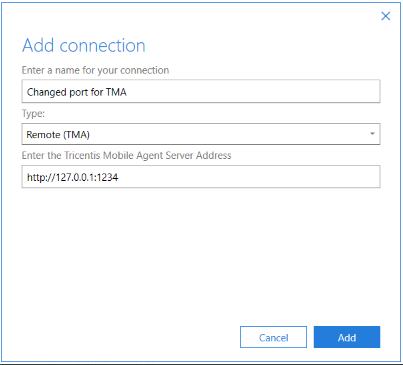Configure mobile tests
Once you have prepared your Android or iOS device for test automation, connected to Tricentis Mobile Agent and created Modules using the Mobile Scan, you need to specify test configuration parameters (TCPs).
The TCPs you specify depend on the mobile platform, application, and connection you use. This topic gives you an overview of all available mobile TCPs. Additionally, it has detailed information on the following TCPs:
For information on how to use mobile TCPs in your tests, see the chapters below.
For information on how to use mobile configuration TCPs that the Mobile Scan creates, see chapter "Use Mobile configurations".
Mobile TCPs overview
The table below lists all TCPs that you can configure for your mobile tests.
|
Mobile TCP |
Description |
|---|---|
|
TMAServer |
Add this TCP to specify the Tricentis Mobile Agent server address. |
|
AppiumServer |
Add this TCP to specify the Appium server address. For more information, see chapter "Specify the AppiumServer TCP". |
|
Add this TCP if you automate hybrid or mobile web applications:
|
|
|
DeviceName |
Add this TCP to specify the device on which you want to execute your mobile tests. If you connect only one Android device to your computer, you don't need to specify the DeviceName TCP. For detailed information, see chapter "Specify the DeviceName TCP". |
|
ExecuteInParallel |
If you want to run your mobile tests in parallel, use this TCP with the value True. |
|
Add this TCP if you run your tests in online clouds using iOS simulators. When you use a simulator, set this parameter to True. You can also use this TCP for local or remote test automation if you want to overwrite a default identification mechanism. |
|
|
LiveView |
Add this TCP and set its value to True to enable Live View during test execution. |
|
Add this TCP in the following situations:
|
|
|
ScreenFlow |
Add this TCP and set its value to True to automatically save the screenshots of TestStepValues with ActionMode Input. If you add this TCP, you must also add the ScreenFlowPath parameter. |
|
ScreenFlowPath |
Specify the path where you want Tricentis Tosca to automatically save the screenshots of TestStepValues with ActionMode Input. If you add this TCP, you must also add the ScreenFlow parameter. |
|
SkipVisibilityCheck |
Add this TCP and set its value to False, if you want Tricentis Tosca to check control visibility for test automation. By default,Tricentis Tosca checks control visibility for local execution and it doesn't check control visibility for execution in the clouds. For detailed information, see chapter "Configure tests in online clouds". |
|
TapByCoordinates |
Add this TCP if you want to simulate a tap on a control for which you specified a {CLICK} action. Use this TCP as a fall-back mechanism if you experience steering issues related to the {CLICK} action. For detailed information, see chapter "Enable the fall-back mechanism for {CLICK} action". |
|
UseXBrowserForMobile |
Add this TCP if you want to use XBrowser Engine 3.0 instead of Mobile Engine 3.0. If you experience steering issues related to controls and frames, add this TCP and set its value to True. |
Specify the AppiumServer TCP
You must specify the Appium server address in the following situations:
-
If you run your tests in the clouds. For detailed information, see chapter "Configure tests in online clouds".
-
If you connect to Local (TMA), the default predefined address is http://127.0.0.1:8585/.

TMAServer value for Local (TMA)
-
If you connect to Remote (TMA), specify the Tricentis Mobile Agent server address in the format http://<ip_address>:<port_number>/.

TMAServervalue for Remote (TMA)
Structure of the Appium server address
For remote connections, the Appium server address consists of the following elements:
-
The IP address of your PC.
-
Appium port. The Appium port that you defined while starting the Tricentis Mobile Agent.
For the structure of the Appium server address in the clouds, see chapter "Configure tests in online clouds".
Change the Appium server default port
The Appium server default port is 8585. To use a different port, follow these steps:
-
Open the agent-configuration.json file. By default, it's located at C:\Users\<username>\AppData\Roaming\Tricentis Mobile\Agent.
-
Go to "bindPort" and enter the new port number.

agent-configuration.json file
-
Save and close the file.
If you've changed the Appium server default port 8585, connect to Remote (TMA) and specify the Tricentis Mobile Agent server address http://127.0.0.1:<changed_port_number>/.

Select Remote (TMA) type for changed port
Specify the DeviceName TCP
The table below explains which value you need to enter for the DeviceName TCP.
|
Situation |
TCP Value |
|---|---|
|
One locally connected iOS device |
Enter Auto or leave this parameter empty. |
|
Multiple locally connected iOS devices |
Enter Auto or leave this parameter empty if you want to trigger the test automation on a random device. If you want to trigger the test automation on a specific device, enter the UDID of this device. |
|
One locally connected Android device |
You don't need to specify this test configuration parameter. |
|
Multiple locally connected Android devices |
Enter Auto or leave this parameter empty if you want to trigger the test automation on a random device. If you want to trigger the test automation on a specific device, enter the ID of this device. Alternatively, if you don't want to provide the name of your device, you can enter the OSVersion TCP instead. |
|
Android emulator |
Enter the full name of the emulated device which is displayed in the emulator. |
|
iOS simulator |
Enter the full name of the simulated device which is displayed in the simulator. |
|
iOS or Android test automation in clouds |
Enter the name of the device, emulator, or simulator that is displayed in the cloud. For detailed information, see chapter "Configure tests in online clouds". |
You can find the IDs of your Android and iOS devices, simulators, and emulators on the Tricentis Mobile Agent.